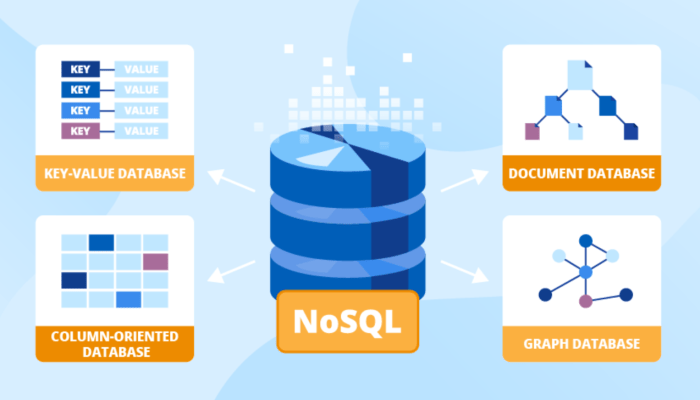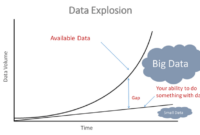NoSQL databases have revolutionized the way data is stored and managed, offering a flexible and scalable solution to the limitations of traditional SQL databases. Dive into the world of NoSQL databases and discover the key differences that set them apart in the realm of data management.
Introduction to NoSQL Databases

NoSQL databases, or “Not Only SQL” databases, are a type of database management system that provides a flexible way to store and manage data that is not easily organized into traditional relational database tables. Unlike SQL databases, which are structured and use a predefined schema, NoSQL databases are schema-less and can handle various types of data, such as unstructured, semi-structured, and structured data.
Main Differences Between NoSQL and SQL Databases
- NoSQL databases are schema-less, allowing for flexibility in data storage, while SQL databases require a predefined schema.
- NoSQL databases are designed to scale horizontally, making them suitable for handling large volumes of data and high traffic loads.
- NoSQL databases are optimized for specific data models, such as document-oriented, key-value, column-family, or graph databases, while SQL databases are designed for relational data.
Examples of Popular NoSQL Databases
- MongoDB: A document-oriented database that stores data in flexible, JSON-like documents.
- Cassandra: A distributed, wide-column store database designed to handle large amounts of data across multiple commodity servers.
- Redis: A key-value store database that supports various data structures like strings, lists, sets, and hashes.
Types of NoSQL Databases

NoSQL databases are categorized into four main types: document, key-value, column-family, and graph. Each type serves specific use cases and offers unique performance characteristics.
Document Databases
Document databases store data in flexible, semi-structured documents like JSON or XML. They are ideal for content management systems, e-commerce platforms, and real-time analytics. Examples include MongoDB, Couchbase, and CouchDB.
Key-Value Databases, NoSQL databases
Key-value databases store data as a collection of key-value pairs. They are efficient for simple data retrieval and storage, making them suitable for caching, session storage, and real-time bidding systems. Redis, DynamoDB, and Riak are popular key-value databases.
Column-Family Databases
Column-family databases organize data into columns instead of rows, making them efficient for storing and retrieving large amounts of data. They are commonly used in data warehousing, time series data, and logging applications. Apache Cassandra and HBase are notable examples of column-family databases.
Graph Databases
Graph databases represent data as nodes, edges, and properties, making them ideal for complex relationships and network analysis. They excel in social networks, fraud detection, and recommendation engines. Neo4j, Amazon Neptune, and ArangoDB are prominent graph databases.
Features and Advantages of NoSQL Databases
NoSQL databases offer several key features that set them apart from traditional SQL databases. These features provide unique advantages, including improved scalability and flexibility.
Key Features of NoSQL Databases
- No Schema Constraints: NoSQL databases do not require a predefined schema, allowing for flexible data models and easier adaptation to changing data requirements.
- Distributed Architecture: NoSQL databases are designed to be distributed across multiple nodes, enabling horizontal scaling for handling large volumes of data.
- High Availability: NoSQL databases typically offer built-in replication and failover mechanisms, ensuring high availability and fault tolerance.
- Performance Optimization: NoSQL databases are optimized for specific use cases, such as real-time analytics, IoT applications, or content management, leading to improved performance.
Advantages of Using NoSQL Databases
- Scalability: NoSQL databases excel at horizontal scaling, making it easier to handle growing datasets and increasing read and write operations without sacrificing performance.
- Flexibility: The schema-less nature of NoSQL databases allows for agile development and quick adjustments to data structures, making them ideal for dynamic or evolving applications.
- Cost-Effective: NoSQL databases can be more cost-effective than traditional SQL databases, especially when dealing with large-scale distributed systems or cloud environments.
- Support for Unstructured Data: NoSQL databases can efficiently store and process unstructured data types like documents, graphs, or key-value pairs, offering more flexibility in data handling.
Data Modeling in NoSQL Databases
Data modeling in NoSQL databases differs significantly from SQL databases due to their schema-less nature. Unlike SQL databases, which require a predefined schema, NoSQL databases offer flexibility in data modeling by allowing the storage of unstructured, semi-structured, and structured data without the need for a fixed schema.
Document-oriented Data Modeling
In document-oriented NoSQL databases like MongoDB, data is stored in flexible, JSON-like documents. Each document can have its own unique structure, and related data can be nested within a single document. For example, in a collection of customer documents, each document may contain information such as name, address, and orders placed, all within the same document.
Key-value Data Modeling
Key-value NoSQL databases like Redis store data as key-value pairs, where each key is unique and maps to a specific value. This simple data model allows for quick retrieval of data but may lack the complexity of relationships found in SQL databases. For instance, a key-value store may contain keys representing user IDs with corresponding values storing user information.
Graph Data Modeling
Graph databases like Neo4j model data in nodes, edges, and properties. Nodes represent entities, edges denote relationships between nodes, and properties provide additional information about nodes and edges. This type of data modeling is ideal for scenarios requiring complex relationships and traversals, such as social networks or recommendation systems.
Best Practices for Data Modeling in NoSQL Databases
- Understand the data access patterns and queries before designing the data model.
- Denormalize data when necessary to improve read performance and reduce the need for complex joins.
- Utilize indexes and secondary keys to enhance query performance.
- Consider the scalability requirements of the application when designing the data model.
- Regularly review and optimize the data model based on evolving application needs.
Querying and Indexing in NoSQL Databases

Querying and indexing play crucial roles in optimizing performance and retrieving data efficiently in NoSQL databases. Let’s explore how these concepts work hand in hand.
Querying in NoSQL Databases
Querying in NoSQL databases involves retrieving data based on specific criteria without the need for complex joins or predefined schemas. NoSQL databases support various query methods that allow for flexible data retrieval.
- Document-based databases like MongoDB use query languages such as MongoDB Query Language (MQL) to retrieve data by specifying key-value pairs or conditions.
- Graph databases like Neo4j utilize the Cypher Query Language to traverse relationships between nodes and fetch connected data efficiently.
- Key-value stores like Redis enable simple queries based on keys, making data retrieval fast and efficient.
Indexing in NoSQL Databases
Indexes are essential in NoSQL databases to speed up query execution by creating efficient access paths to data. By indexing specific fields or attributes, databases can quickly locate relevant information without scanning the entire dataset.
- For example, in MongoDB, creating indexes on frequently queried fields can significantly improve query performance by reducing the number of documents that need to be scanned.
- In Cassandra, secondary indexes can be created to optimize queries that filter data based on non-primary key columns.
Common Query Languages in NoSQL Databases
Various NoSQL databases support specific query languages tailored to their data models and structures. These query languages offer flexibility and efficiency in data retrieval operations.
- CQL (Cassandra Query Language) is used in Apache Cassandra to interact with the database and perform queries efficiently.
- Gremlin is a query language for graph databases that enables users to navigate and query graph structures in databases like JanusGraph and Apache TinkerPop.
- Redis commands provide a simple yet powerful way to query and manipulate data in Redis key-value stores.
Real-world Applications of NoSQL Databases
NoSQL databases have found widespread applications across various industries due to their flexibility and scalability. Let’s explore some real-world examples of how NoSQL databases are utilized.
Industries Benefiting from NoSQL Databases
- E-commerce: Companies like Amazon and eBay use NoSQL databases to handle large volumes of customer data, product information, and transactions efficiently.
- Social Media: Platforms like Facebook and Twitter leverage NoSQL databases to store and manage user-generated content, interactions, and real-time data streams.
- Telecommunications: Telecom companies use NoSQL databases to manage subscriber data, call records, and network performance data effectively.
Use Cases Where NoSQL Databases Outperform SQL Databases
- Big Data Processing: NoSQL databases excel in handling unstructured and semi-structured data, making them ideal for big data analytics and processing tasks.
- Real-time Applications: NoSQL databases offer high performance and low latency, making them suitable for real-time applications like IoT, gaming, and financial trading platforms.
- Scalability: NoSQL databases can easily scale horizontally to accommodate growing data volumes and user loads compared to traditional SQL databases.
Support for Big Data and Real-time Applications
- Data Replication: NoSQL databases support data replication across multiple nodes, ensuring high availability and fault tolerance for big data applications.
- Distributed Computing: NoSQL databases leverage distributed computing architecture to process large datasets efficiently and handle real-time data streams seamlessly.
- Data Sharding: NoSQL databases use data sharding to partition large datasets across multiple servers, enabling parallel processing and improved performance for big data workloads.
As we conclude our exploration of NoSQL databases, it’s evident that their unique features and advantages make them a compelling choice for modern data-intensive applications. Embracing the flexibility and scalability of NoSQL databases can pave the way for innovative solutions in the ever-evolving landscape of data management.
Business reporting plays a crucial role in enhancing decision-making through data. By analyzing financial statements, performance metrics, and market trends, businesses can make informed decisions that drive growth. Utilizing advanced reporting tools and technologies can provide valuable insights that guide strategic planning and investment decisions. Learn more about Business reporting Enhancing Decision-Making Through Data to stay ahead in today’s competitive business landscape.
Analytical dashboards are powerful tools that unlock data insights for business success. These visual representations of key metrics and KPIs allow stakeholders to monitor performance, identify trends, and make data-driven decisions. By utilizing interactive dashboards, organizations can streamline reporting processes and improve operational efficiency. Discover how Analytical Dashboards Unlocking Data Insights for Business Success can transform your business operations and drive growth.
Data-driven reports are essential for making informed decisions with data. By collecting, analyzing, and interpreting data, organizations can gain valuable insights that guide strategic decision-making. Utilizing reporting tools and technologies can help businesses identify opportunities, mitigate risks, and optimize performance. Explore the benefits of Data-driven reports Making Informed Decisions with Data to stay competitive in today’s data-driven business environment.



